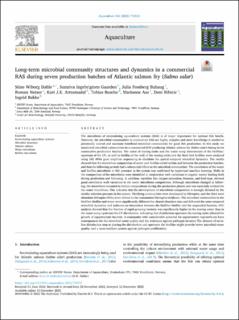| dc.contributor.author | Dahle, Stine Veronica Wiborg | |
| dc.contributor.author | Gaarden, Sunniva Ingebrigtsen | |
| dc.contributor.author | Buhaug, Julia Fossberg | |
| dc.contributor.author | Netzer, Roman | |
| dc.contributor.author | Attramadal, Kari | |
| dc.contributor.author | Busche, Tobias | |
| dc.contributor.author | Aas, Marianne | |
| dc.contributor.author | Ribicic, Deni | |
| dc.contributor.author | Bakke, Ingrid | |
| dc.date.accessioned | 2024-02-05T10:15:35Z | |
| dc.date.available | 2024-02-05T10:15:35Z | |
| dc.date.created | 2022-12-21T08:36:46Z | |
| dc.date.issued | 2023 | |
| dc.identifier.citation | Aquaculture. 2023, 565 . | en_US |
| dc.identifier.issn | 0044-8486 | |
| dc.identifier.uri | https://hdl.handle.net/11250/3115535 | |
| dc.description.abstract | The microbiota of recirculating aquaculture systems (RAS) is of major importance for optimal fish health. However, the microbial communities in commercial RAS are highly complex and more knowledge is needed to potentially control and maintain beneficial microbial communities for good fish production. In this study we monitored microbial communities in a commercial RAS producing Atlantic salmon fry (Salmo salar) during seven consecutive production batches. The water of rearing tanks and the water sump downstream of the biofilter/upstream of the UV, as well as biofilm of the wall of the rearing tanks and the fixed bed biofilter were analysed using 16S rRNA gene amplicon sequencing to elucidate the spatial-temporal microbial dynamics. The results showed that the microbiota composition of water and biofilm varied within and between the production batches, and that the fallowing periods had a substantial effect on the microbial communities. The correlation of the water and biofilm microbiota to fish presence in the system was confirmed by supervised machine learning. Shifts in the composition of the microbiota were identified in conjunction with variations in organic matter loading both during production and fallowing. In addition, variables like oxygen saturation, biomass, and feed type, showed good correlation with variations in the water microbiota composition. Although microbiota changed at fallowing, the microbiota returned to similar compositions during the production phases and was especially evident for the water microbiota. This indicates that the development of microbiota composition is strongly dictated by the similar selection pressure in the system. Nitrifying communities were dominated by Nitrospira, and the third most abundant Nitrospira OTUs were related to the comammox Nitrospira nitrificans. The microbial communities in the biofilter biofilm and water were significantly different but shared abundant taxa and followed the same temporal microbial dynamics and indicates an interaction between the biofilter biofilm and the suspended bacteria. CFU analysis showed that the fraction of rapid-growing bacteria was significantly higher in the rearing water than in the water sump upstream the UV disinfection, indicating that disinfection upstream the rearing tanks allowed for growth of opportunistic bacteria. A community with considerable potential for opportunistic regrowth can have consequences for the microbial water quality and the resistance against pathogen invasion The absence of an in-line disinfection step or placing the disinfection unit upstream the biofilter might provide better microbial water quality and a more resilient system against pathogen proliferation. | en_US |
| dc.language.iso | eng | en_US |
| dc.publisher | Elsevier | en_US |
| dc.rights | Navngivelse 4.0 Internasjonal | * |
| dc.rights.uri | http://creativecommons.org/licenses/by/4.0/deed.no | * |
| dc.title | Long-term microbial community structures and dynamics in a commercial RAS during seven production batches of Atlantic salmon fry (Salmo salar) | en_US |
| dc.title.alternative | Long-term microbial community structures and dynamics in a commercial RAS during seven production batches of Atlantic salmon fry (Salmo salar) | en_US |
| dc.type | Peer reviewed | en_US |
| dc.type | Journal article | en_US |
| dc.description.version | publishedVersion | en_US |
| dc.source.pagenumber | 16 | en_US |
| dc.source.volume | 565 | en_US |
| dc.source.journal | Aquaculture | en_US |
| dc.identifier.doi | 10.1016/j.aquaculture.2022.739155 | |
| dc.identifier.cristin | 2096067 | |
| cristin.ispublished | true | |
| cristin.fulltext | original | |
| cristin.qualitycode | 2 | |

